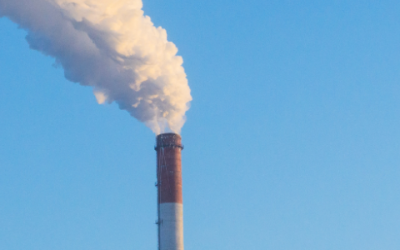Understanding a company's ecological footprint

When we talk about our ecological footprint, we often think of our carbon footprint- the quantity of greenhouse gases (GHGs) emitted per year by an organization or an individual.
Yet, although they are linked, they are two distinct footprints. The ecological footprint concerns not only GHG emissions, but also the impact on ecosystems.
Companies have an ecological footprint, and their activities influence the ecological footprints of individuals and countries. In this article, we take a closer look at the ecological footprint of companies and the issues involved.
1. What is the ecological footprint?
1.1. A measure of human pressure on nature.
2. Companies' contribution to the global ecological footprint.
3. How do you assess a company's ecological footprint?
3.1 Performing an environmental analysis
3.2. Drawing up a carbon balance
4. How can a company's ecological footprint be reduced?
What is the ecological footprint?
🌍A measure of human pressure on nature
The ecological footprint is an indicator of human pressure on natural resources and ecosystem services. More precisely, it is a measure of the surface area required to satisfy human needs, i.e. the production and consumption of resources, energy, food, services and infrastructure, and the absorption of waste. It also takes into account the technologies available, and therefore depends on the country concerned.
The OECD defines this footprint as "a measure in hectares of the biologically productive area required to support a human population of a given size".
It is measured in global hectares (hag), i.e. hectares whose productivity is equal to average productivity. In France, for example, this will be 4.3 hag / person in 2022 (estimate, according to the Global Footprint Network).
Another order of magnitude used is the number of planets needed to meet the current needs of the world's population. In 2023, Global Footprint Network estimated that it would take 1.7 planets to generate what the world's population consumes today. In France, this number rises to 2 .86 planets (in 2022, again according to Global Footprint Network).
🔥Le dépassement écologique
In 2023, ecological overshoot was reached on August 2, 2023. On August 2, humanity consumed all that the Earth could regenerate in 1 year. It was on this occasion that the Global Footprint Network estimated that it would take 1.7 planets to meet the current needs of the planet's population.
If the ecological surplus is linked to the ecological footprint, it is different: it is calculated as the difference between the global ecological footprint and biocapacity, i.e. what the planet can provide in 1 year. The result is an ecological surplus or deficit.
The day of ecological overshoot is advancing year by year, and reflects production and consumption needs that are increasing to the point where they can no longer be met by a single planet. It's a notion that calls for sobriety, moderation and a reduction in our consumption of resources, services and goods. It also calls for the sustainable development of businesses and society.
Companies' contribution to the global ecological footprint.
📈Consumption of resources
To run its business, an organization needs a variety of natural resources, such as water, minerals, wood, materials and so on. These have to be extracted, then processed, manufactured and transformed into the product or service sold by the company. The consequences of this resource consumption are directly linked to ecological overshoot.
🚯Waste generation
A company will generate waste in the production and use of its product. Plastic or electronic waste, for example. This waste has a direct impact on biodiversity, and raises the question of how it should be treated: recycled, incinerated or buried?
☁️Émissions greenhouse gases (GHG)
To produce a good, service or process, a company will emit GHGs at every stage of its life cycle. For example, for a product, GHGs will be emitted when raw materials are extracted, processed, produced, transported, delivered, used (if applicable) and end-of-life. These GHG emissions are directly responsible for climate change, and contribute to a company's carbon and ecological footprint.
⛰️Utilisation space
A company needsspace to run its business. Premises, production plants, warehouses and so on. This need leads to the adaptation and conversion of land to industrial needs (deforestation, soil artificialisation, construction, etc.), which has a direct impact on biodiversity. Land use change is the leading cause of biodiversity loss.
How do you assess a company's ecological footprint?
Evaluating a company's ecological footprint makes us aware of the pressure it exerts on the environment, the footprint it leaves and the damage it causes. It's an essential step in identifying the main levers for action to reduce it!
🌱Environmentalanalysis
An analysis will enable you to assess the environmental impact of your product, process or service, over its entire life cycle and using a multi-criteria analysis.
This analysis is often carried out as part of the process of obtaining ISO 14001 certification. This certification attests that an environmental management system complying with ISO 14001 has been put in place, and that the organization's objectives are in line with the environmental balance.
✅Carrying out a carbon audit
As mentioned above, the carbon footprint is part of the ecological footprint. After assessing the environmental impact of its activities, an organization can draw up a carbon footprint to quantify its greenhouse gas emissions by year and by emission source.
How can you reduce your company's ecological footprint?
📉Reduce carbon footprint
Once the carbon footprint has been established and the greenhouse gas emissions quantified, a low carbon strategy is an excellent way to reduce your carbon and ecological footprint!♻️Repenser its business: eco-design
Rethinking a good, service or product so that it has less impact on the environment and nature, and is in line with environmental objectives, helps to reduce its ecological footprint. According to ADEME, this is a " multi-criteria " and " multi-stage "eco-design approach.
- Multi-criteria, because it takes into account all the environmental criteria on which the product, process or service may have an impact (water, climate change, biodiversity, energy, etc.).
- Multi-stage, because it takes into account the entire life cycle of the product, process or service.
Committing to an eco-design approach is a way of participating in the environmental transition and sustainable development of society. This approach also has several advantages for companies:
- Improve the organization's image and competitiveness, by meeting new consumer expectations and standing out from the competition.
- Anticipate future regulations.
- Innovate and create new market opportunities.
- Gaining resilience and adapting activities to environmental challenges.
Reducing your ecological footprint also means adopting eco-actions at work!
You know all about a company's ecological footprint - now it's time to take action!







